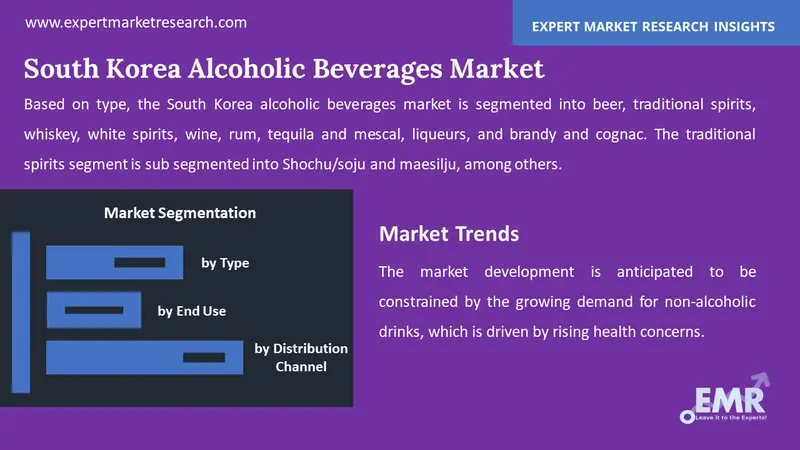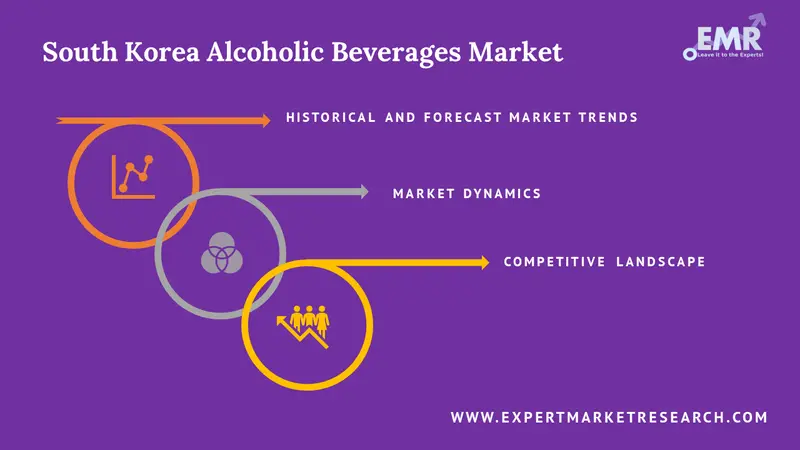
Consumer Insights
Uncover trends and behaviors shaping consumer choices today
Procurement Insights
Optimize your sourcing strategy with key market data
Industry Stats
Stay ahead with the latest trends and market analysis.
The South Korea alcoholic beverages market reached a value of approximately USD 27.69 Billion in 2025. The market is projected to grow at a CAGR of 4.80% between 2026 and 2035, reaching a value of around USD 44.25 Billion by 2035.
Base Year
Historical Period
Forecast Period
The functional food and beverages experienced a growth of a CAGR of 1.9% between 2018 and 2022.
In 2022, soft drinks accounted for 84% of the FF beverages market, totalling USD 498.4 million.
According to NZTE, between 2018 and 2024, South Korea's food and beverages sector experienced steady growth, with a CAGR of 4%.
Compound Annual Growth Rate
4.8%
Value in USD Billion
2026-2035
*this image is indicative*
The demand for alcoholic beverages in South Korea is propelled by the increase in the production of flavoured and functional beverages, ready-to-drink options, and beverages made with alternative ingredients such as plant-based milk substitutes. Manufacturers are developing single-serve and portable packaging formats, such as cans, pouches, and bottles, that are suitable for consumption anywhere, anytime.
Moreover, beverage companies use technology to improve product development, streamline manufacturing processes, and optimise distribution channels, further driving the demand for beverages. According to the Government of Canada, in 2022, South Korea's beer market ranked as the 10th largest globally, with beer sales totalling US$11.0 billion.
Rising demand for craft spirits, increase in health consciousness, surge in e-commerce and digital marketing, and shift in consumer preference are the major trends impacting the South Korea alcoholic beverages market growth.
Craft spirits such as whiskey, gin, and vodka are increasingly favoured for their distinct tastes, limited production runs, and commitment to premium ingredients, catering to seekers of genuine drinking experience.
Although alcoholic beverages remain popular, South Korean consumers are becoming more health conscious. This has increased the desire for low-alcohol or alcohol-free options and drinks containing natural ingredients and functional benefits.
E-commerce platforms provide convenience and access to diverse products. In contrast, digital marketing initiatives, collaborations with influencers, and social media campaigns enable brands to connect with consumers and boost alcoholic beverage sales.
South Korean consumers, especially the younger generation, are more open to exploring a variety of alcoholic drinks beyond traditional choices like soju and beer. This trend boosts demand for premium and imported liquors.
The alcoholic beverages industry is being propelled by the willingness of consumers to invest in superior-quality and premium beverages, which provide distinctive flavour profiles and craftsmanship. Moreover, government policies that encourage competition, innovation, and responsible consumption can boost market growth and attract investment in the industry.
There is a growing emphasis among South Korean consumers on sustainability and ethical standards within the beverage industry. This entails a desire for eco-friendly packaging, responsibly sourced ingredients, and a preference for brands that prioritise sustainability and social responsibility.

Read more about this report - REQUEST FREE SAMPLE COPY IN PDF
"South Korea Alcoholic Beverages Market Report and Forecast 2026-2035” offers a detailed analysis of the market based on the following segments:
Market Breakup by Packaging Type
Market Breakup by End Use
Market Breakup by Distribution Channel
Wine contributes to the South Korea alcoholic beverages market growth as wine is progressively intertwining with South Korean social and dining customs, shaped by the emergence of wine-focused dining venues and wine festivals.
The demand for premium and high-quality wines is on the rise among South Korean consumers, who are willing to invest more for exceptional flavour and genuine quality. Moreover, wine is seen as a healthier option compared to other alcoholic drinks because of its lower alcohol content and potential health advantages, like the presence of antioxidants in red wine.
Traditional spirits like soju and makgeolli possess deep cultural significance in South Korea. Despite their traditional origins, there have been advancements in both the production and marketing of traditional spirits to accommodate shifting consumer preferences.
Pubs, bars, and restaurants drive growth in the South Korea alcoholic beverages market share by offering a diverse range of alcoholic beverages, including local and international beers, wines, spirits, and cocktails.
Numerous pubs, bars, and restaurants organise promotions, happy hours, and special events focused on alcoholic beverages. These activities draw in customers, boost foot traffic, and stimulate consumption, resulting in heightened sales and revenue.
Retail outlets offer convenience by providing one-stop shopping for alcoholic beverages along with other grocery and household items. Moreover, retailers seize the premiumization trend by providing a carefully curated array of upscale and speciality alcoholic beverages, catering to consumers seeking quality, craftsmanship, and distinctive drinking encounters.

Read more about this report - REQUEST FREE SAMPLE COPY IN PDF
The beverage companies produce and offer various beverages including vodka, rum, beer, wine, liqueurs, and others of different brands.
Founded in 1997 and is a North America-based company. The company offers various brand products including scotch whiskey, vodka, tequila, gin, rum, beer, wine, liqueurs, and no and low alcohol.
Established in 1950 and is headquartered in Seoul, South Korea. The company offers beverages and liquor products under various brands including Chilsung Cider, Pepsi-Cola, Del Monte, Milkis, and others.
Founded in 2009 and epitomizes the excellence of the Chilean wine sector, consistently delivering quality since its inception. The wine brands offered by the company include Reserva, Red Blend, Devil’s Carnaval, and others.
Established in 1975 and is a Paris, Ile-de-France-based company. The company is the world's premier provider of high-quality spirits, distributing favourite beverage brands to over 160 countries.
*Please note that this is only a partial list; the complete list of key players is available in the full report. Additionally, the list of key players can be customized to better suit your needs.*
Other South Korea alcoholic beverages market key players are Anheuser-Busch InBev NV, HiteJinro Co., Ltd, Heineken NV, Oriental Brewery Co., Carlsberg A/S, Jeju Beer Co., Ltd., Beam Suntory Inc, Muhak Co Ltd, Molson Coors Beverage Company, and Asahi Group Holdings Ltd, among others.
United States Flavoured Alcoholic Beverages Market
Australia Alcoholic Beverages Market
Mexico Alcoholic Beverages Market
West Africa Alcoholic Beverages Market
South Korea Alcoholic Beverages Manufacturers
South Korea Beverage Ingredients Technologies
South Korea Beverage Consumer Behavior Trends
South Korea Beverage Distribution And Retail Channels




*While we strive to always give you current and accurate information, the numbers depicted on the website are indicative and may differ from the actual numbers in the main report. At Expert Market Research, we aim to bring you the latest insights and trends in the market. Using our analyses and forecasts, stakeholders can understand the market dynamics, navigate challenges, and capitalize on opportunities to make data-driven strategic decisions.*
Get in touch with us for a customized solution tailored to your unique requirements and save upto 35%!
The market was valued at USD 27.69 Billion in 2025.
The market is projected to grow at a CAGR of 4.80% between 2026 and 2035.
The revenue generated from the South Korea alcoholic beverages market is expected to reach USD 44.25 Billion in 2035.
The market is categorised according to the type, which includes beer, traditional spirits, whiskey, white spirits, wine, rum, tequila and mescal, liqueurs, and brandy and cognac.
The market key players are Diageo Plc, Lotte Chilsung Beverage Co., Ltd., Casillero del Diablo, Pernod Richard S.A., Anheuser-Busch InBev NV, HiteJinro Co., Ltd, Heineken NV, Oriental Brewery Co., Carlsberg A/S, Jeju Beer Co., Ltd., Beam Suntory Inc, Muhak Co Ltd, Molson Coors Beverage Company, and Asahi Group Holdings Ltd, among others.
Based on the end-use, the market is divided into pubs, bars, restaurants, and retail.
Based on the distribution channel, the market is divided into hypermarkets and supermarkets, convenience stores, speciality stores, department stores and others.
Explore our key highlights of the report and gain a concise overview of key findings, trends, and actionable insights that will empower your strategic decisions.
| REPORT FEATURES | DETAILS |
| Base Year | 2025 |
| Historical Period | 2019-2025 |
| Forecast Period | 2026-2035 |
| Scope of the Report |
Historical and Forecast Trends, Industry Drivers and Constraints, Historical and Forecast Market Analysis by Segment:
|
| Breakup by Packaging Type |
|
| Breakup by End Use |
|
| Breakup by Distribution Channel |
|
| Market Dynamics |
|
| Competitive Landscape |
|
| Companies Covered |
|
Datasheet
One User
USD 2,499
USD 2,249
tax inclusive*
Single User License
One User
USD 3,999
USD 3,599
tax inclusive*
Five User License
Five User
USD 4,999
USD 4,249
tax inclusive*
Corporate License
Unlimited Users
USD 5,999
USD 5,099
tax inclusive*
*Please note that the prices mentioned below are starting prices for each bundle type. Kindly contact our team for further details.*
Flash Bundle
Small Business Bundle
Growth Bundle
Enterprise Bundle
*Please note that the prices mentioned below are starting prices for each bundle type. Kindly contact our team for further details.*
Flash Bundle
Number of Reports: 3
20%
tax inclusive*
Small Business Bundle
Number of Reports: 5
25%
tax inclusive*
Growth Bundle
Number of Reports: 8
30%
tax inclusive*
Enterprise Bundle
Number of Reports: 10
35%
tax inclusive*
How To Order

Select License Type
Choose the right license for your needs and access rights.

Click on ‘Buy Now’
Add the report to your cart with one click and proceed to register.

Select Mode of Payment
Choose a payment option for a secure checkout. You will be redirected accordingly.
Gain insights to stay ahead and seize opportunities.

Get insights & trends for a competitive edge.

Track prices with detailed trend reports.

Analyse trade data for supply chain insights.

Leverage cost reports for smart savings

Enhance supply chain with partnerships.

Connect For More Information
Our expert team of analysts will offer full support and resolve any queries regarding the report, before and after the purchase.
Our expert team of analysts will offer full support and resolve any queries regarding the report, before and after the purchase.
We employ meticulous research methods, blending advanced analytics and expert insights to deliver accurate, actionable industry intelligence, staying ahead of competitors.
Our skilled analysts offer unparalleled competitive advantage with detailed insights on current and emerging markets, ensuring your strategic edge.
We offer an in-depth yet simplified presentation of industry insights and analysis to meet your specific requirements effectively.
Share